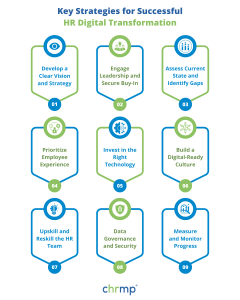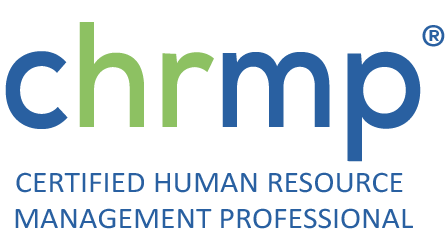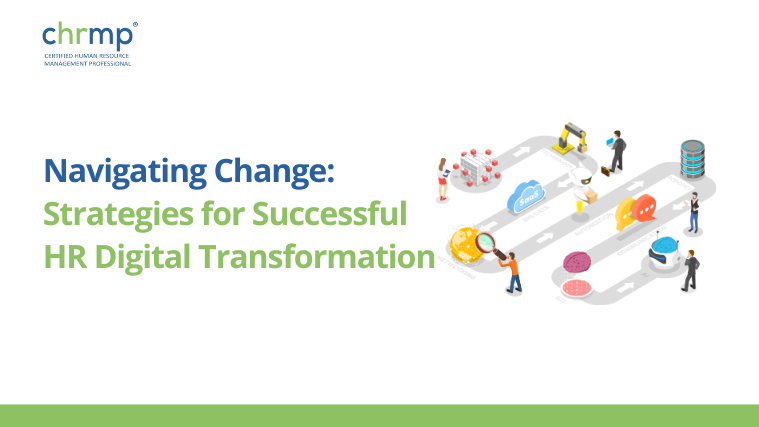Table of Contents
ToggleDigital Transformation in HR: Strategies for Success
Introduction
In today’s rapidly evolving business landscape, digital transformation has become a critical imperative for organizations across all sectors. For HR professionals, embracing digital transformation in HR is not just about adopting new technologies, but fundamentally rethinking how human resources functions operate. This blog aims to provide practical strategies for HR professionals to successfully navigate the journey of digital transformation.
Thank you for reading this post, don't forget to subscribe!Understanding HR Digital Transformation
Definition
HR digital transformation refers to the integration of digital technologies into all areas of human resources, fundamentally changing how HR operates and delivers value to the organization. This transformation encompasses various aspects such as recruiting, onboarding, performance management, employee engagement, learning and development, payroll, and more.
Scope
Digital transformation in human resources impacts numerous areas. For instance, in recruitment, it involves using AI-powered tools to screen resumes and conduct initial interviews. In employee engagement, digital platforms can facilitate continuous feedback and recognition systems. Performance management can be enhanced with real-time analytics and data-driven insights. Learning and development are revolutionized through e-learning platforms and virtual reality training modules.
Benefits
Key benefits of digitalization in HR include increased efficiency through automation of repetitive tasks, enhanced data-driven decision-making capabilities, improved employee experience with more personalized and responsive services, and gaining a competitive edge in attracting and retaining top talent. Additionally, digital HR solutions enable better compliance management, more accurate payroll processing, and improved workforce analytics.
The Current Landscape of HR Digital Transformation
Trends and Statistics
The trend towards digital human resources management is accelerating, with a significant increase in the adoption of digital HR solutions. According to a recent study by Deloitte, 56% of companies are redesigning their HR programs to leverage digital and mobile tools. Another report by PwC indicates that 79% of CEOs are concerned about the availability of key skills, underscoring the need for digital HR strategies to attract and develop talent.
Challenges
Despite its benefits, HR digital transformation poses several challenges. Common obstacles include resistance to change from employees accustomed to traditional ways of working, concerns about data privacy and security, and skill gaps within the HR team that may hinder the effective implementation of new technologies. Additionally, the initial cost of investing in digital HR solutions and the complexity of integrating these solutions with existing systems can be significant barriers.
Key Strategies for Successful HR Digital Transformation

1: Develop a Clear Vision and Strategy
A successful transformation HR initiative starts with a clear vision. This involves aligning the digital transformation goals with the overall business objectives to ensure coherence and relevance. It’s important to articulate a compelling vision that communicates the benefits of digital transformation to all stakeholders. This vision should be supported by a strategic roadmap that outlines the key milestones, timelines, and resources required for the transformation.
2: Engage Leadership and Secure Buy-In
Leadership plays a crucial role in driving HR and digital transformation. Securing executive sponsorship and support is essential for the success of the transformation efforts. Leaders must champion the transformation initiative, provide the necessary resources, and foster a culture that embraces change. Engaging leadership involves presenting a strong business case for digital transformation, highlighting the potential ROI and strategic advantages.
3: Assess the current state and Identify Gaps
Conducting a digital maturity assessment helps in understanding the current state and identifying gaps in technology, skills, and processes. This assessment provides a baseline for planning the transformation journey. It involves evaluating the existing HR systems, processes, and capabilities to identify areas that need improvement or upgrading. This step is crucial for setting realistic goals and expectations for the transformation.
4: Prioritize Employee Experience
The success of digital transformation in HRM largely depends on user acceptance. Prioritizing a user-friendly approach and involving employees in the process ensures higher engagement and smoother adoption. This means designing HR processes and systems with the end-user in mind, ensuring they are intuitive, accessible, and responsive to employee needs. Regularly seeking employee feedback and making iterative improvements based on this feedback can significantly enhance the employee experience.
5: Invest in the Right Technology
Choosing the right digital HR solutions is crucial. It’s important to select technologies that integrate seamlessly with existing systems and address the specific needs of the organization. Key considerations include scalability, flexibility, user-friendliness, and vendor support. Additionally, exploring emerging technologies such as AI, machine learning, and blockchain can provide innovative solutions to HR challenges and drive further efficiencies.
6: Build a Digital-Ready Culture
Fostering a culture of innovation and continuous learning is key to sustaining digital transformation. Encouraging collaboration and agility within the HR team helps in adapting to new changes effectively. This involves promoting a growth mindset, where employees are open to learning new skills and embracing new technologies. Creating an environment where experimentation is encouraged and failure is seen as a learning opportunity can significantly enhance the organization’s digital readiness.
7: Upskill and Reskill the HR Team
Digital transformation demands new skills. Providing HR digital transformation courses and continuous learning opportunities ensures that the HR team is well-equipped to handle new technologies and processes. This includes training on digital tools, data analytics, and change management. Additionally, fostering a culture of lifelong learning within the HR team helps in keeping up with the rapidly evolving digital landscape.
8: Data Governance and Security
Ensuring data privacy and compliance is paramount. Implementing robust data governance frameworks protects sensitive information and builds trust among employees. This involves establishing clear policies and procedures for data handling, ensuring compliance with relevant regulations, and investing in security technologies to safeguard against data breaches. Regular audits and reviews of data practices can help in maintaining high standards of data governance.
9: Measure and Monitor Progress
Setting key performance indicators (KPIs) helps in tracking the progress of digital transformation initiatives. Regular reviews and adjustments ensure that the transformation efforts are on the right track. KPIs can include metrics such as time to hire, employee engagement scores, training completion rates, and system adoption rates. Regularly communicating progress to all stakeholders helps in maintaining momentum and addressing any issues promptly.
Case Studies of Successful HR Digital Transformation
Case Study 1: Unilever
Unilever embarked on a digital HR strategy to transform its recruitment process. By leveraging AI and machine learning, Unilever was able to reduce hiring time by 75% and improve the quality of hires. The new system automated the initial screening of candidates, using AI algorithms to shortlist the best candidates based on predefined criteria. This transformation not only enhanced the candidate experience but also significantly reduced recruitment costs. Additionally, Unilever introduced digital onboarding processes, improving the integration of new hires into the organization (Source: Unilever’s Digital HR Transformation Case Study, Deloitte).
Case Study 2: IBM
IBM’s digital transformation in human resources focused on enhancing employee engagement through a digital platform. The platform provided personalized learning experiences and real-time feedback, resulting in a 20% increase in employee engagement and a 15% improvement in employee retention rates. IBM used AI to deliver personalized learning paths based on employee profiles and career aspirations. The platform also enabled continuous feedback and recognition, fostering a culture of ongoing development and appreciation (Source: IBM’s HR Digital Transformation, Harvard Business Review).
Future Trends in HR Digital Transformation
Emerging Technologies
Emerging technologies such as AI, machine learning, and blockchain are poised to further revolutionize HR. AI can be used for predictive analytics in talent management, identifying potential high performers and flight risks. Machine learning algorithms can help in personalizing employee learning experiences and improving talent acquisition processes. Blockchain technology can enhance the security and transparency of HR processes, such as verifying candidate credentials and managing employee records.
Evolving Roles of HR
As digital transformation progresses, the role of HR professionals is evolving. HR is transitioning from administrative tasks to strategic roles, focusing on driving business outcomes and enhancing employee experience. HR professionals are increasingly becoming data analysts, leveraging insights from HR analytics to inform strategic decisions. They are also acting as change agents, leading the organization through digital transformation and fostering a culture of innovation and continuous improvement.
Conclusion
Navigating the journey of digital transformation in HR requires a strategic approach, strong leadership, and a culture that embraces change. By following the strategies outlined in this blog, HR professionals can successfully lead their organizations through the digital transformation process, unlocking new levels of efficiency and employee satisfaction. The journey may be challenging, but the rewards of a digitally transformed HR function are immense.





